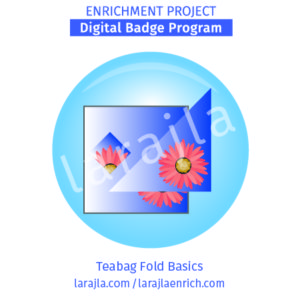
Originally, squares of patterned paper were folded and assembled to create a kaleidoscope effect. This is where we will begin our adventures into teabag folding.
Steps
1. Equipment.
The equipment you need is very basic. Collect these items from around your house.
- Cutting mat
- Metal-edged ruler
- Craft knife
- Bone folder
- Paper adhesive / double-sided tape
NOTE: You can replace the cutting mat, ruler and knife with a cutter that has all these features. Depending on the model of cutter, a light beneath the board can be beneficial.
2. Paper.
You can purchase teabag folding papers (less likely) or use patterned paper, including scrapbook paper and gift wrap. You need to be sure that each square looks exactly the same. This will give the kaleidoscope effect. Look for squares you can use for teabag folding.
The biggest issue you’ll have with your paper is where you will use it. If you intend on placing your item into a scrapbook or other media that requires archival materials, you will need to purchase pre-printed or blank paper with this in mind. Most gift wrap papers are not archival.
3. Punches.
Using a punch is a great way to control the size of your squares. You can also flip it over so you can see the exact pattern you are punching. This is essential when you’re using larger patterns on items such as gift wrap. Explore different sized square punches that you can use to punch out paper. If you have one available, practice punching out a group of squares that look the same.
4. Online.
You can find free squares and sheets online. Do a search to find a design / color you like and print it out. Make sure you have multiple squares of the same size.
NOTE: This badge has a supplement with a sheet and sample medallion.
5. Tips.
Here are a few tips before you start folding. Find additional tips online.
- Cut square as straight as possible
- Crease folds with bone folder for sharper edges
- Make sure you fold the squares the same way
- Runny glue will make your paper wrinkle
- If your squares aren’t perfect, do a bit of trimming after folding
6. Fold.
There are many ways to fold squares. Start with the folds presented in the supplement listed below. Check the links in “Sites to Explore” or do a bit of surfing and find one that looks interesting to you. Fold a square and determine if you like the look.
7. Medallions.
Some people call them medallions, others rosettes — but it’s the same thing. To create a medallion, you’ll typically need eight (8) squares of paper. They look best when the eight squares are identical. If you plan to place your completed medallion on a card, your square sizes should be no larger than 2 inches. When assembling, some people like to do one full medallion at a time, others will do a set of two or three pieces and allow them to dry before putting them together. Find what works best for you.
NOTE: Some patterns require a different number of squares.
8. Frames.
Frames are similar to medallions, except instead of making the pieces adjoin snugly at the center, you slide them out a bit, making the inside circle larger. Create a frame from your folded squares. You can use more than eight to make a larger frame.
9. Center.
Changing up your center can make a big difference in the design of your projects. A button with twine gives you a more “country” look while a large sparkling rhinestone can make it look a little fancier. Of course, you can also add photos to the center of either a medallion or frame. Experiment with different looks with changing out your center embellishment.
10. Ornaments.
Add a string to the medallion to create an ornament. You can also use a frame design to place photos into your ornaments. To make it easier, you may want to assemble your project on a circle of color-coordinating paper to give it a strong base as well as a place to write the date you created your unique ornament. Experiment with adapting your medallions and frames into ornaments.
11. Usage.
You can put your teabag folded items on cards, invitations, scrapbook pages, or give away as gifts. I’ve used them to embellish artistic trading cards and standard frames as well. Experiment and find more ways you can use this technique.
NOTE: If you plan on using these in a scrapbook, be sure to use archival products.
12. Beyond.
To help advertise my first teabag folding class, I took 12-inch pieces of scrapbook paper and made a medallion. I placed clockworks on it and created a teabag folded clock. Though this craft is based on small items, don’t let it stop your experimenting.
Badge and Supplement Files
Member Level
- 0EP_B_BPG_TeabagFoldB_2in_12up_MS1_larajla — generic badge printable
- 0EP_BLIST_TeabagFoldB_MS1_larajla — badge items per membership level
- 0EP_BSET0_TeabagFoldB_MS1_larajla —badge set and related badges
- 0EP_SUPP0_TeabagFoldB_Journal_MS1_larajla — badge journal
- 0EP_SUPP0_TeabagFoldB_Planner_MS1_larajla — badge planner
- 0EP_SUPPL_TeabagFoldB_MS1_larajla — supplements currently available per membership level
Supplement Fun
- 0EP_SUPP0_Craft Fun_GS Teabag Tiles_MS2_larajla — Craft Fun: Girl Scout teabag tiles
- 0EP_SUPP0_Tech Fun_Teabag_Square_01_MS2_larajla — Technique Fun: Square teabag fold (use for Girl Scout tiles)
- 0EP_SUPP0_Tech Fun_Teabag_Square_02_MS2_larajla — Technique Fun: Square teabag fold
- 0EP_SUPP0_Tech Fun_Teabag_Square_03_MS2_larajla — Technique Fun: Square teabag fold
- 0EP_SUPP0_Tech Fun_Teabag_Square_04_MS2_larajla — Technique Fun: Square teabag fold
- 0EP_SUPP0_Tech Fun_Teabag_Square_05_MS2_larajla — Technique Fun: Square teabag fold
Sites to Explore
- www.craftycarddesigns.com/teabags/teabags.asp
- clipartandcrafts.com/clipart/backgrounds/index.htm
- msvicr.50webs.com/index.html
- zrosemarie.50webs.com
- members.iinet.net.au/~tswk_mac/teabag.html
- web.archive.org/web/20170630193225/http://britton.disted.camosun.bc.ca/jbteabagtiles.htm
- goldapete.wordpress.com/category/kaleidoscope-origami-or-teabag-folds
- www.craftymarie.com/2016/02/tea-bag-folding-instructions-beginners.html
- www.scrapbookscrapbook.com/tea-bag-folding-instructions.html
- www.origami-resource-center.com/tea-bag-folding.html
- www.origami-resource-center.com/kite.html
- www.cardinspirations.co.uk/section.php/428/1/an_introduction_to_tea_bag_folding
- mystudio3d.tripod.com/teabagnewfold.htm
- gomakesomething.com/ht/folding/tea-bag-folding
Get the infographic here > larajla blog post
Get the PDFs of the badge program / supplements here
